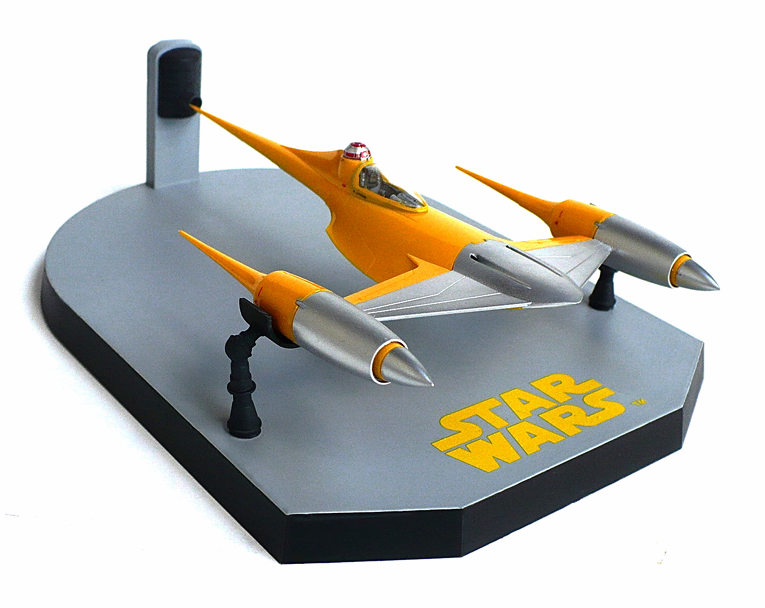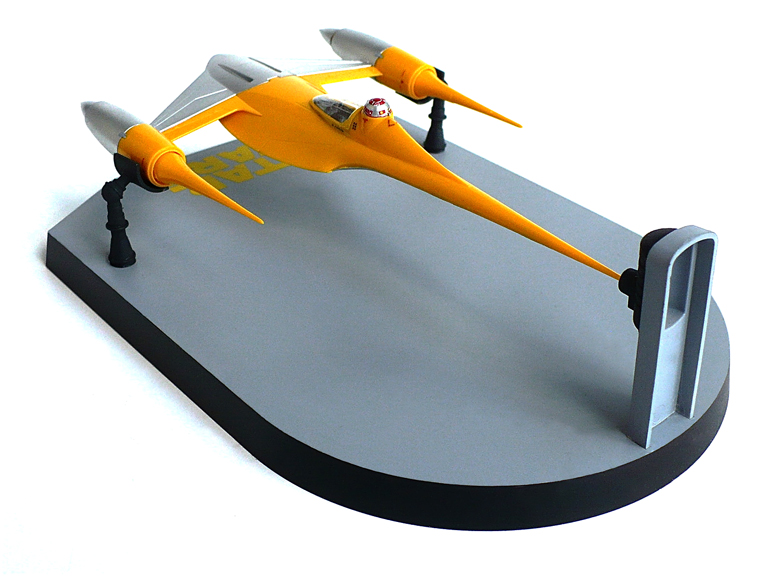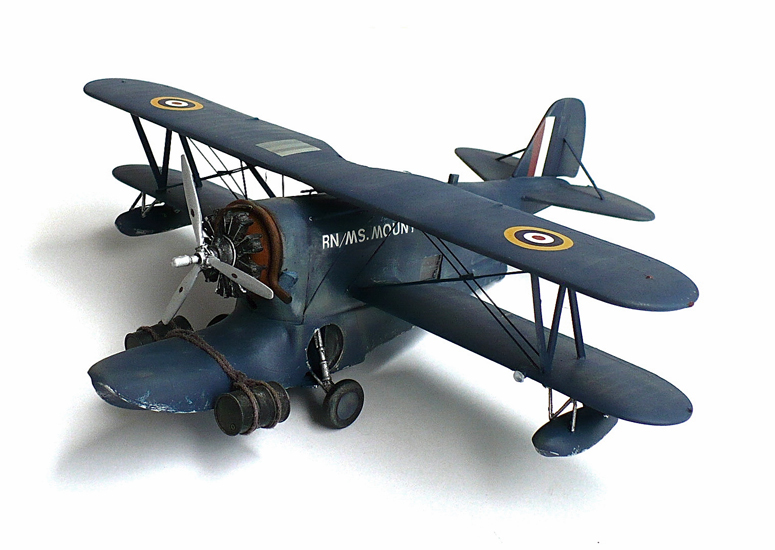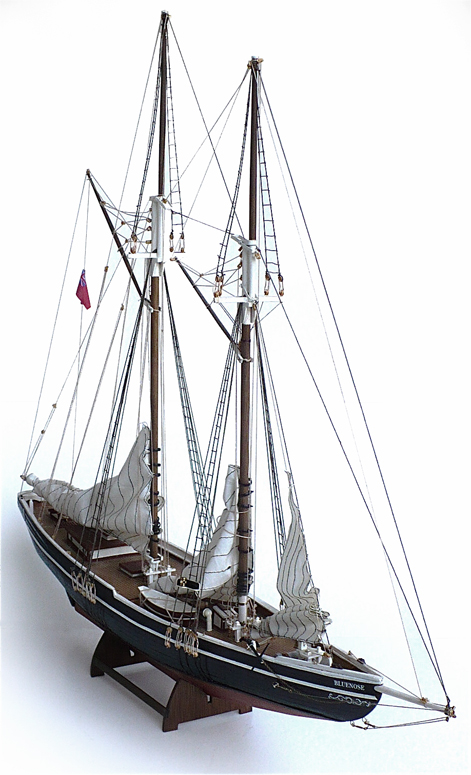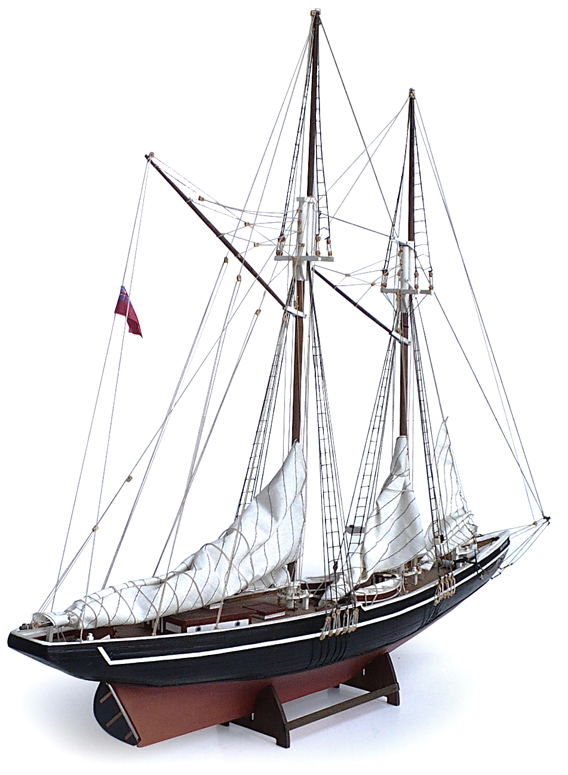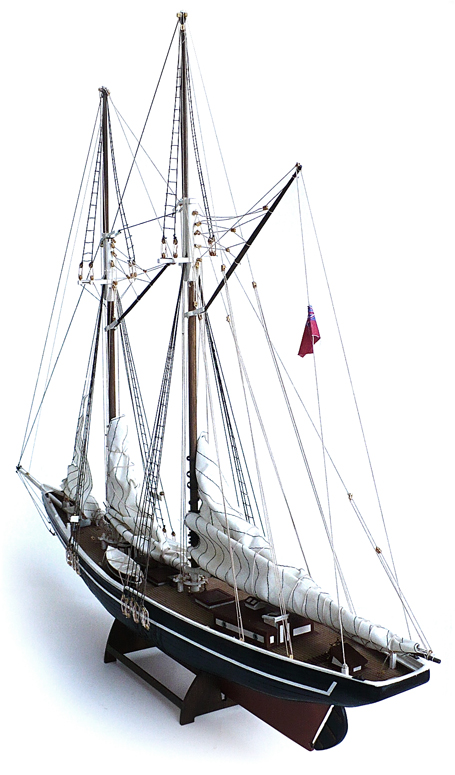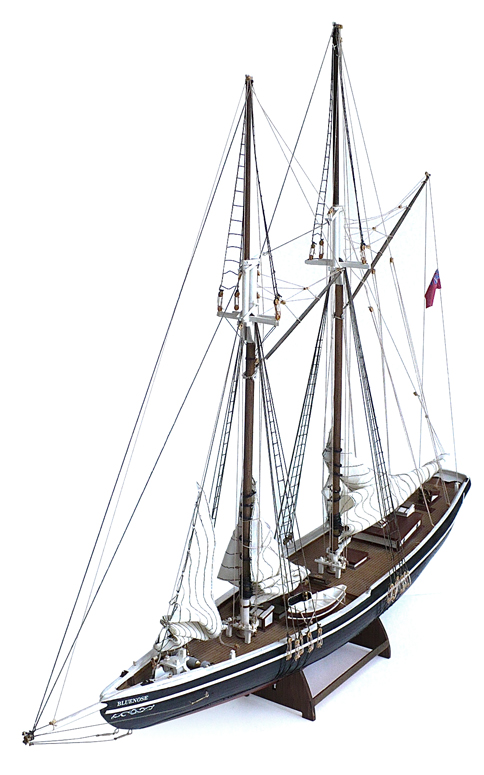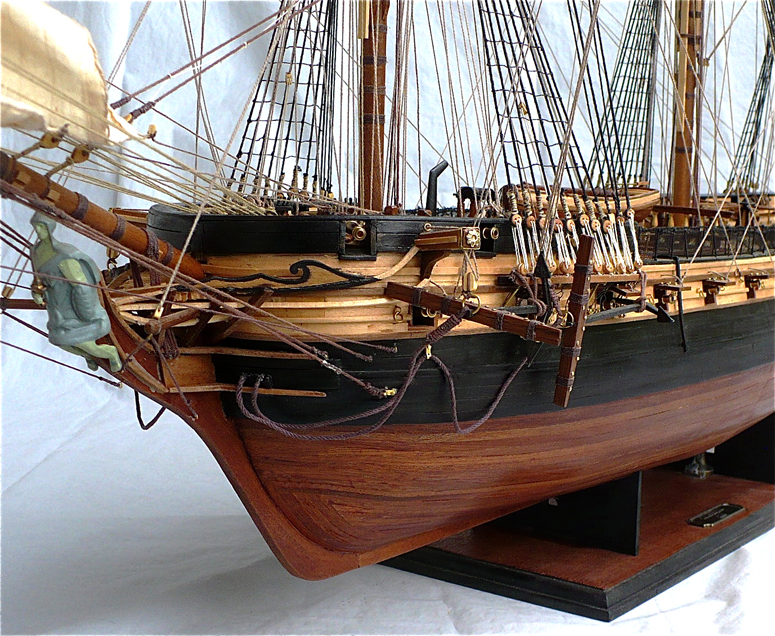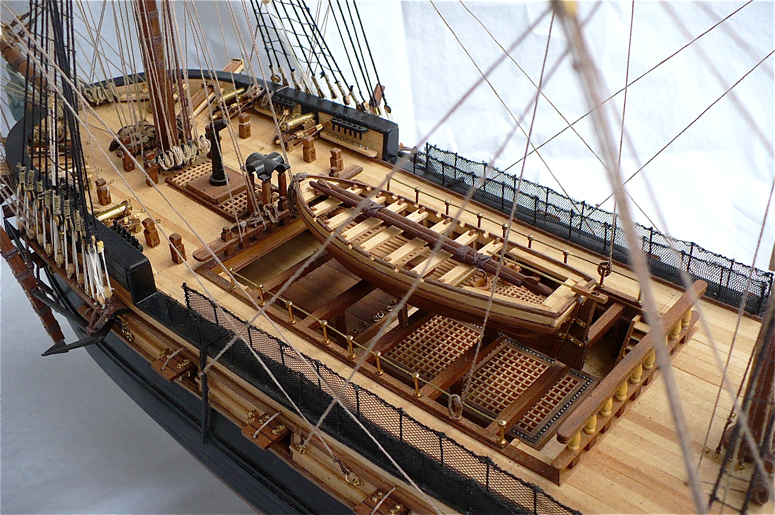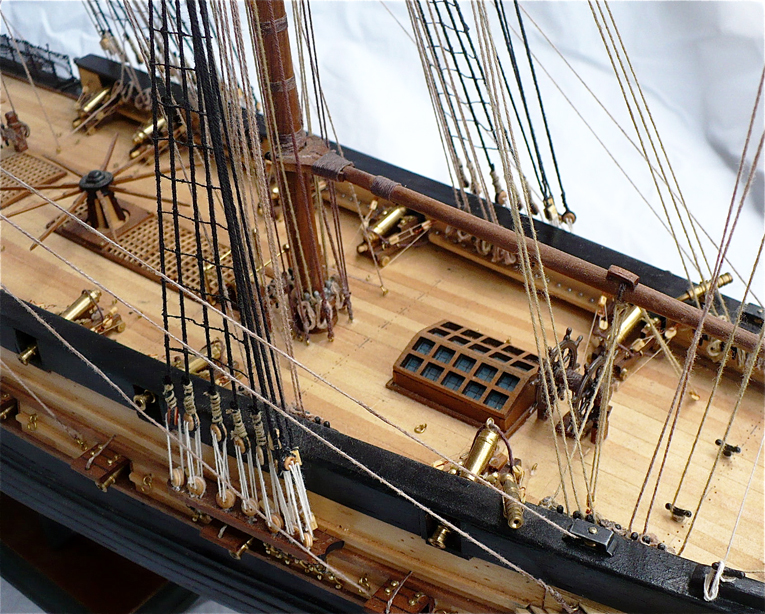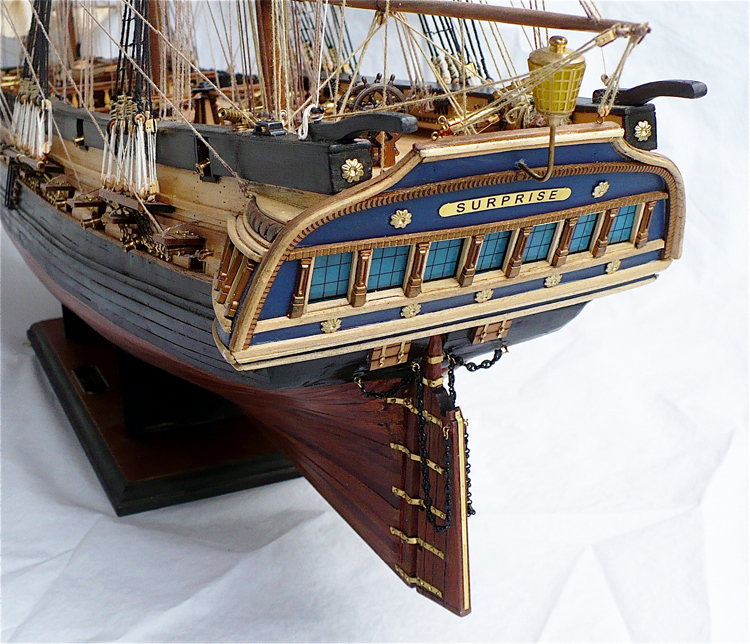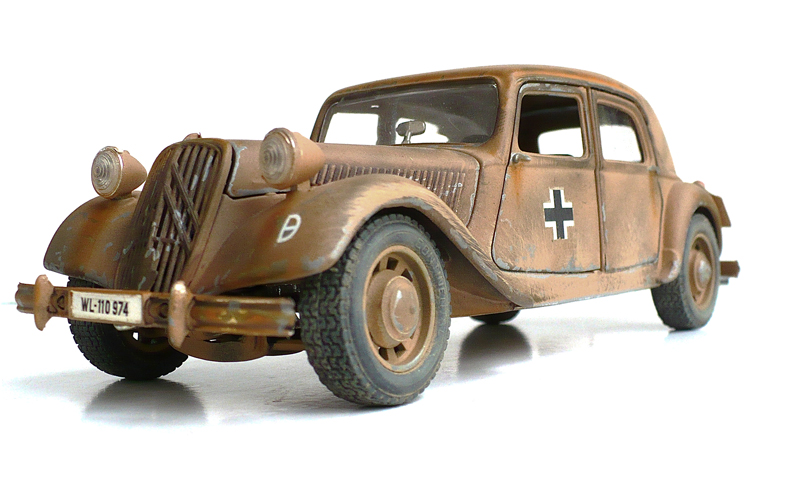Here are some images of Fine Molds 1/72 scale Naboo N-1 Starfighter from the Star Wars universe.
From StarWars.com
Protecting the skies and space around Naboo is the N-1 starfighter. Its
sleek design exemplifies the philosophy of art and function witnessed
throughout Naboo technology. Its twin radial J-type engines are capped
in gleaming chrome and trail long delicate-looking finials behind the
ship's single-pilot compartment. Behind the pilot sits a standard
astromech droid, plugged into an abbreviated, ventrally-fed socket which
requires the droid to compress slightly in order to fit within the
vessel's curves. The fighter features twin blaster cannons, twin
fire-linked torpedo launchers, and a capable automatic pilot feature.
Translate
Sunday, August 31, 2014
Saturday, August 30, 2014
Providence Whaleboat
Here are some images of Artesania Latina's 1/25 scale Providence Whaleboat.
From Wikipedia"
A whaleboat is a type of open boat that is relatively narrow and pointed at both ends, enabling it to move either forwards or backwards equally well. It was originally developed for whaling, and later became popular for work along beaches, since it does not need to be turned around for beaching or refloating. The term "whaleboat" may be used informally of larger whalers, or of a boat used for whale watching.
Today whaleboats are used as safety vessels aboard marine vessels. The United States Coast Guard has been using them since 1791. Their simple open structure allows for easy access and personnel loading in the event of an emergency. These whaleboats are now considered very important, and highly regimented safety vessels. Boats must include a hatchet, lifeboat compass, lifeboat sea anchor, emergency signal mirror, emergency drinking water, lifeboat first aid kit, jack knife with can opener, lifeboat bilge pump,and emergency provisions. On modern warships, a relatively light and seaworthy boat for transport of ship's crew may be referred to as a whaleboat or whaler. It may also refer to a type of vessel designed as a lifeboat or "monomoy" used for recreational and competitive rowing in the San Francisco Bay Area and coastal Massachusetts.
Whaleboats were also extensively used in warfare. Colonel Benjamin Church is credited with first pioneering their use for amphibious combat operations against Abenaki and Mi'kmaq tribes in what is today Maine and Acadia . His troops, New England colonial forces and Native allies from southern New England, used them as early as 1696 (during King William's War). Others in the Northeastern borderlands followed suit and they were utilized throughout the imperial conflicts of the early 18th century, and extensively used by both British and colonial troops during the French and Indian war. Units that made extensive use of whaleboats were the 7th Massachusetts Infantry Regiment at the siege of Louisburg in 1745, often referred to as "the whaleboat regiment," and Gorham's Rangers, formed in 1744, initially a company of Indians mainly from Cape Cod, many of whom were employed as whalers, and which later evolved into a British Army ranger company in the 1750s and 1760s. John Bradstreet's Bateaux and Transport service, a corps of armed boatmen tasked with moving supplies on inland waterways during the French and Indian War also used whaleboats extensively. In 1772, American colonials used whaleboats to attack and destroy HMS Gaspée in Narragansett Bay. During the American Revolutionary War, there were many whaleboat raids, including one with 230 men led by Return J. Meigs, Sr. to sack Sag Harbor on Long Island in 1777. On December 7, 1782, two fleets of whaleboats fought a bloody battle on Long Island Sound known as the Boats Fight. During the desperate hand-to-hand conflict, every man involved was either killed or injured.
The whaleboat's design takes after those the Vikings used during the 11th century, around the time Beowulf was written and Leif Erickson came to America briefly, before the Vikings really made their mark on English culture. As a whaling vessel, it fulfilled its purposes for what it went through and its “superior handling characteristics soon made it a popular general-purpose ship’s boat”. The whaleboat generally is outfitted with a dismountable sail post for sailing across seas, but in close proximity, they can use oars for rapid rowing to nearby areas with a large rowing crew. The basics of the whaleboat consists of a rudder, main sail, and occasionally a jib. Without the rudder, the boat would have no steering capabilities, and without the sails, the vessel would have no propulsion, assuming there were no oars or a sizable rowing crew to compensate for the lack of propulsion. After 1850 most were fitted with a centreboard that would keep the boat from swaying too far to one side or another, located in the center of the boat. The main sail would catch the wind, which would in turn push the sail, pushing the boat in the process, and the rudder, depending on the direction the person manning it pointed it at, would push the stern of the boat in a certain direction, steering the whaleboat essentially. The rudder consists of basically two parts: the part that sticks in the water in order to give thrust, and the part the coxswain, or the person steering, holds onto in order to push or pull the first part. The jib sail is a significantly smaller sail that serves to help steer and propel the boat forward as well. By catching the wind at a specific angle, the sail can either double as a second main sail catching the wind, or help by adding “better close-hauled sailing and of setting extra sail with comparatively little labor demand”
Whaleboats became prevalent in ancient Inuit and Yupik culture when trade and other forms of nutrition were sparse. Whaleboats gave them a means of travelling to distant places in order to obtain resources. Natives had to gather sustenance, generally large fish such as whales, when at all possible, from the sea. Whaleboats were not always taken out to sea to hunt whales, but they could also be used to transport dead whales that they had scavenged from the shallow waters. Whaleboats used in whaling had a stout post mounted on the aft deck, around which the steersman would cinch the rope once the whale had been harpooned, and by which the whale would drag the boat until it was killed. Large baleen and bow heads whales became their main export to Europe and the Americas, which in turn would help in revitalizing the trade in their region, an area that ranged from the Bering-Chukchi Sea to eastern Arctic.
Norwegians began to dominate whaling when they turned it into a full-blown industry in 1904. They were more skilled and had better techniques than other civilizations around this same time period. The Norwegians had very efficient gunners, men who fired the weapons, the technology of the Sven Foyn gun and the grenade harpoon, and they utilized the powered whale catcher. Although all these factors were effective and sped trade, the demand of oil was its own issue. Whales were mainly used for their fat that was melted to oilmaybe talk about this process. The Norwegians had a systemtalk about the system in place and partnered with the British to profit. The simple whale boat received a number of modifications throughout this periodexpand on the modifications. What was once a simple single hull, open boat became a body of new technologies to make whaling more efficient. Changes like the use of radar and radio instead of a lookout and new handling tools.
A whaler or whaling ship is a specialized ship, designed for whaling, the catching and/or processing of whales. The former includes the whale catcher – a steam or diesel-driven vessel with a harpoon gun mounted at its bow. The latter includes such vessels as the sail or steam-driven whaleship of the 16th to early 20th century and the floating factory or factory ship of the modern era. There have also been vessels which combined the two activities, such as the bottlenose whalers of the late 19th and early 20th century, and catcher/factory ships of the modern era.
Whaleships had two or more whaleboats, open rowing boats used in the capture of whales. Whaleboats brought the captured whales to the whaleships to be flensed or cut up. Here the blubber was rendered into oil using two or three try-pots set in a brick furnace called the tryworks.
At first, whale catchers either brought the whales they killed to a whaling station or factory ship anchored in a sheltered bay or inlet. Later, with the development of the slipway at the ship's stern, whale catchers were able to transfer their catch to factory ships operating in the open sea.
From Wikipedia"
A whaleboat is a type of open boat that is relatively narrow and pointed at both ends, enabling it to move either forwards or backwards equally well. It was originally developed for whaling, and later became popular for work along beaches, since it does not need to be turned around for beaching or refloating. The term "whaleboat" may be used informally of larger whalers, or of a boat used for whale watching.
Today whaleboats are used as safety vessels aboard marine vessels. The United States Coast Guard has been using them since 1791. Their simple open structure allows for easy access and personnel loading in the event of an emergency. These whaleboats are now considered very important, and highly regimented safety vessels. Boats must include a hatchet, lifeboat compass, lifeboat sea anchor, emergency signal mirror, emergency drinking water, lifeboat first aid kit, jack knife with can opener, lifeboat bilge pump,and emergency provisions. On modern warships, a relatively light and seaworthy boat for transport of ship's crew may be referred to as a whaleboat or whaler. It may also refer to a type of vessel designed as a lifeboat or "monomoy" used for recreational and competitive rowing in the San Francisco Bay Area and coastal Massachusetts.
Whaleboats were also extensively used in warfare. Colonel Benjamin Church is credited with first pioneering their use for amphibious combat operations against Abenaki and Mi'kmaq tribes in what is today Maine and Acadia . His troops, New England colonial forces and Native allies from southern New England, used them as early as 1696 (during King William's War). Others in the Northeastern borderlands followed suit and they were utilized throughout the imperial conflicts of the early 18th century, and extensively used by both British and colonial troops during the French and Indian war. Units that made extensive use of whaleboats were the 7th Massachusetts Infantry Regiment at the siege of Louisburg in 1745, often referred to as "the whaleboat regiment," and Gorham's Rangers, formed in 1744, initially a company of Indians mainly from Cape Cod, many of whom were employed as whalers, and which later evolved into a British Army ranger company in the 1750s and 1760s. John Bradstreet's Bateaux and Transport service, a corps of armed boatmen tasked with moving supplies on inland waterways during the French and Indian War also used whaleboats extensively. In 1772, American colonials used whaleboats to attack and destroy HMS Gaspée in Narragansett Bay. During the American Revolutionary War, there were many whaleboat raids, including one with 230 men led by Return J. Meigs, Sr. to sack Sag Harbor on Long Island in 1777. On December 7, 1782, two fleets of whaleboats fought a bloody battle on Long Island Sound known as the Boats Fight. During the desperate hand-to-hand conflict, every man involved was either killed or injured.
The whaleboat's design takes after those the Vikings used during the 11th century, around the time Beowulf was written and Leif Erickson came to America briefly, before the Vikings really made their mark on English culture. As a whaling vessel, it fulfilled its purposes for what it went through and its “superior handling characteristics soon made it a popular general-purpose ship’s boat”. The whaleboat generally is outfitted with a dismountable sail post for sailing across seas, but in close proximity, they can use oars for rapid rowing to nearby areas with a large rowing crew. The basics of the whaleboat consists of a rudder, main sail, and occasionally a jib. Without the rudder, the boat would have no steering capabilities, and without the sails, the vessel would have no propulsion, assuming there were no oars or a sizable rowing crew to compensate for the lack of propulsion. After 1850 most were fitted with a centreboard that would keep the boat from swaying too far to one side or another, located in the center of the boat. The main sail would catch the wind, which would in turn push the sail, pushing the boat in the process, and the rudder, depending on the direction the person manning it pointed it at, would push the stern of the boat in a certain direction, steering the whaleboat essentially. The rudder consists of basically two parts: the part that sticks in the water in order to give thrust, and the part the coxswain, or the person steering, holds onto in order to push or pull the first part. The jib sail is a significantly smaller sail that serves to help steer and propel the boat forward as well. By catching the wind at a specific angle, the sail can either double as a second main sail catching the wind, or help by adding “better close-hauled sailing and of setting extra sail with comparatively little labor demand”
Whaleboats became prevalent in ancient Inuit and Yupik culture when trade and other forms of nutrition were sparse. Whaleboats gave them a means of travelling to distant places in order to obtain resources. Natives had to gather sustenance, generally large fish such as whales, when at all possible, from the sea. Whaleboats were not always taken out to sea to hunt whales, but they could also be used to transport dead whales that they had scavenged from the shallow waters. Whaleboats used in whaling had a stout post mounted on the aft deck, around which the steersman would cinch the rope once the whale had been harpooned, and by which the whale would drag the boat until it was killed. Large baleen and bow heads whales became their main export to Europe and the Americas, which in turn would help in revitalizing the trade in their region, an area that ranged from the Bering-Chukchi Sea to eastern Arctic.
Norwegians began to dominate whaling when they turned it into a full-blown industry in 1904. They were more skilled and had better techniques than other civilizations around this same time period. The Norwegians had very efficient gunners, men who fired the weapons, the technology of the Sven Foyn gun and the grenade harpoon, and they utilized the powered whale catcher. Although all these factors were effective and sped trade, the demand of oil was its own issue. Whales were mainly used for their fat that was melted to oilmaybe talk about this process. The Norwegians had a systemtalk about the system in place and partnered with the British to profit. The simple whale boat received a number of modifications throughout this periodexpand on the modifications. What was once a simple single hull, open boat became a body of new technologies to make whaling more efficient. Changes like the use of radar and radio instead of a lookout and new handling tools.
A whaler or whaling ship is a specialized ship, designed for whaling, the catching and/or processing of whales. The former includes the whale catcher – a steam or diesel-driven vessel with a harpoon gun mounted at its bow. The latter includes such vessels as the sail or steam-driven whaleship of the 16th to early 20th century and the floating factory or factory ship of the modern era. There have also been vessels which combined the two activities, such as the bottlenose whalers of the late 19th and early 20th century, and catcher/factory ships of the modern era.
Whaleships had two or more whaleboats, open rowing boats used in the capture of whales. Whaleboats brought the captured whales to the whaleships to be flensed or cut up. Here the blubber was rendered into oil using two or three try-pots set in a brick furnace called the tryworks.
At first, whale catchers either brought the whales they killed to a whaling station or factory ship anchored in a sheltered bay or inlet. Later, with the development of the slipway at the ship's stern, whale catchers were able to transfer their catch to factory ships operating in the open sea.
Monday, August 25, 2014
Grumman AO -12 Duck From Murphy's War "Fly You Bastard Fly!"
Here are some images of Classic Airframe's 1/48 scale Grumman AO - 12 Duck from the movie "Murphy's War".
From Wikipedia"
The Grumman J2F Duck (company designation G-15) was an American single-engine amphibious biplane. It was used by each major branch of the U.S. armed forces from the mid-1930s until just after World War II, primarily for utility and air-sea rescue duties. It was also used by the Argentine Navy, who took delivery of their first Duck in 1937. After the war, J2F Ducks saw service with independent civilian operators, as well as the armed forces of Colombia and Mexico.
The J2F was an improved version of the earlier JF Duck, with its main difference being a longer float.
The J2F-1 Duck first flew on 2 April 1936, powered by a 750 hp (559 kW) Wright R-1820 Cyclone, and was delivered to the U.S. Navy on the same day. The J2F-2 had a Wright Cyclone engine which was boosted to 790 hp (589 kW). Twenty J2F-3 variants were built in 1939 for use by the Navy as executive transports with plush interiors. Due to pressure of work following the United States entry into the war in 1941, production of the J2F Duck was transferred to the Columbia Aircraft Corp of New York. They produced 330 aircraft for the Navy and U.S. Coast Guard. If standard Navy nomenclature practice had been followed, these would have been designated JL-1s, but it was not, and all Columbia-produced airframes were delivered as J2F-6s.
Several surplus Navy Ducks were converted for use by the United States Air Force in the air-sea rescue role as the OA-12 in 1948.
The J2F was an equal-span single-bay biplane with a large monocoque central float which also housed the retractable main landing gear, a similar design to the Leroy Grumman-designed landing gear first used for Grover Loening's early amphibious biplane designs, and later adopted for the Grumman FF fighter biplane. The aircraft had strut-mounted stabilizer floats beneath each lower wing. A crew of two or three were carried in tandem cockpits, forward for the pilot and rear for an observer with room for a radio operator if required. It had a cabin in the fuselage for two passengers or a stretcher.
The Duck's main pontoon was blended into the fuselage, making it almost a flying boat despite its similarity to a conventional landplane which has been float-equipped. This configuration was shared with the earlier Loening OL, Grumman having acquired the rights to Loening's hull, float and undercarriage designs. Like the F4F Wildcat, its narrow-tracked landing gear was hand-cranked.
The J2F was used by the U.S. Navy, Marines, Army Air Forces and Coast Guard. Apart from general utility and light transport duties, its missions included mapping, scouting/observation, anti-submarine patrol, air-sea rescue work, photographic surveys and reconnaissance, and target tug.
J2Fs of the utility squadron of US Patrol Wing 10 were destroyed at Mariveles Bay, Philippines, by a Japanese air raid on 5 January 1942. The only Duck to survive the attack had a dead engine but had been concealed at Cabcaben airfield during the Battle of Bataan, to be repaired afterwards with a cylinder removed from a destroyed J2F-4 submerged in Manila Bay. Following repairs the J2F-4 departed after midnight on 9 April 1942, overloaded with five passengers and the pilot, becoming the last aircraft to depart Bataan before the surrender of the Philippines to the Japanese only hours later. Among its passengers was Carlos P. Romulo (diplomat, politician, soldier, journalist and author) who recounted the flight in his 1942 best-selling book "I Saw the Fall of the Philippines" (Doubleday, Doran & Company, Inc., Garden City, New York 1943, pp. 288–303) for which he received the Pulitzer Prize for Correspond
The United States Coast Guard worked with North South Polar, Inc. to recover a J2F-4 Duck BUNO V-1640 downed in a storm on a Greenland glacier. Two Coast Guard airmen were lost along with a rescued US Army Air Force passenger from a downed B-17 searching for a downed C-53 with five on board. The three men of the Duck are presumed to still be entombed at the site. North South Polar, under the auspices of the US Coast Guard team, located the aircraft in August 2012 resting 38 feet beneath the surface of the ice sheet. As per the mandate of Title 10 of the US Code, North South Polar, the US Coast Guard and the Joint POW/MIA Accounting Command plan to recover the men's remains for proper interment. The Coast Guard and North South Polar are also developing plans to recover the aircraft and restore it to flying condition as a memorial to the aircrew. www.nspolar.us
Noted aircraft collector Kermit Weeks has been the top Duck owner since World War II, owning as many as four. Two of Weeks' J2Fs were traded for other aircraft, one is under restoration, and the fourth is flyable and on display at Fantasy of Flight in Polk City, Florida.
From Wikipedia"
The Grumman J2F Duck (company designation G-15) was an American single-engine amphibious biplane. It was used by each major branch of the U.S. armed forces from the mid-1930s until just after World War II, primarily for utility and air-sea rescue duties. It was also used by the Argentine Navy, who took delivery of their first Duck in 1937. After the war, J2F Ducks saw service with independent civilian operators, as well as the armed forces of Colombia and Mexico.
The J2F was an improved version of the earlier JF Duck, with its main difference being a longer float.
The J2F-1 Duck first flew on 2 April 1936, powered by a 750 hp (559 kW) Wright R-1820 Cyclone, and was delivered to the U.S. Navy on the same day. The J2F-2 had a Wright Cyclone engine which was boosted to 790 hp (589 kW). Twenty J2F-3 variants were built in 1939 for use by the Navy as executive transports with plush interiors. Due to pressure of work following the United States entry into the war in 1941, production of the J2F Duck was transferred to the Columbia Aircraft Corp of New York. They produced 330 aircraft for the Navy and U.S. Coast Guard. If standard Navy nomenclature practice had been followed, these would have been designated JL-1s, but it was not, and all Columbia-produced airframes were delivered as J2F-6s.
Several surplus Navy Ducks were converted for use by the United States Air Force in the air-sea rescue role as the OA-12 in 1948.
The J2F was an equal-span single-bay biplane with a large monocoque central float which also housed the retractable main landing gear, a similar design to the Leroy Grumman-designed landing gear first used for Grover Loening's early amphibious biplane designs, and later adopted for the Grumman FF fighter biplane. The aircraft had strut-mounted stabilizer floats beneath each lower wing. A crew of two or three were carried in tandem cockpits, forward for the pilot and rear for an observer with room for a radio operator if required. It had a cabin in the fuselage for two passengers or a stretcher.
The Duck's main pontoon was blended into the fuselage, making it almost a flying boat despite its similarity to a conventional landplane which has been float-equipped. This configuration was shared with the earlier Loening OL, Grumman having acquired the rights to Loening's hull, float and undercarriage designs. Like the F4F Wildcat, its narrow-tracked landing gear was hand-cranked.
The J2F was used by the U.S. Navy, Marines, Army Air Forces and Coast Guard. Apart from general utility and light transport duties, its missions included mapping, scouting/observation, anti-submarine patrol, air-sea rescue work, photographic surveys and reconnaissance, and target tug.
J2Fs of the utility squadron of US Patrol Wing 10 were destroyed at Mariveles Bay, Philippines, by a Japanese air raid on 5 January 1942. The only Duck to survive the attack had a dead engine but had been concealed at Cabcaben airfield during the Battle of Bataan, to be repaired afterwards with a cylinder removed from a destroyed J2F-4 submerged in Manila Bay. Following repairs the J2F-4 departed after midnight on 9 April 1942, overloaded with five passengers and the pilot, becoming the last aircraft to depart Bataan before the surrender of the Philippines to the Japanese only hours later. Among its passengers was Carlos P. Romulo (diplomat, politician, soldier, journalist and author) who recounted the flight in his 1942 best-selling book "I Saw the Fall of the Philippines" (Doubleday, Doran & Company, Inc., Garden City, New York 1943, pp. 288–303) for which he received the Pulitzer Prize for Correspond
The United States Coast Guard worked with North South Polar, Inc. to recover a J2F-4 Duck BUNO V-1640 downed in a storm on a Greenland glacier. Two Coast Guard airmen were lost along with a rescued US Army Air Force passenger from a downed B-17 searching for a downed C-53 with five on board. The three men of the Duck are presumed to still be entombed at the site. North South Polar, under the auspices of the US Coast Guard team, located the aircraft in August 2012 resting 38 feet beneath the surface of the ice sheet. As per the mandate of Title 10 of the US Code, North South Polar, the US Coast Guard and the Joint POW/MIA Accounting Command plan to recover the men's remains for proper interment. The Coast Guard and North South Polar are also developing plans to recover the aircraft and restore it to flying condition as a memorial to the aircrew. www.nspolar.us
Noted aircraft collector Kermit Weeks has been the top Duck owner since World War II, owning as many as four. Two of Weeks' J2Fs were traded for other aircraft, one is under restoration, and the fourth is flyable and on display at Fantasy of Flight in Polk City, Florida.
Grumman F9F- Panther
Here are some more images of Revell's 1/48 scale Grumman F9F- Panther.
This model displays the markings of the Golden Dragons from the 1954 movie The Bridges of Toko-Ri starring William Holden, Grace Kelly, Fredric March and Micky Rooney.
From Wikipedia"
The Grumman F9F Panther was the manufacturer's first jet fighter and one of the United States Navy's first successful carrier-based jet fighters. A single-engined, straight-winged day fighter, it was fitted with an armament of four 20 mm (0.79 in) cannons and could carry a wide assortment of air-to-ground munitions. The Panther was used extensively by the U.S. Navy and the United States Marine Corps in the Korean War. Total F9F production was 1,382. Several variants were exported to Argentina. The Panther was the first jet aircraft used by the Blue Angels flight team, being used by them from 1949 through to late 1954. The design evolved into the swept wing Grumman F-9 Cougar.
Development studies at the Grumman company for jet-powered fighter aircraft began near the end of World War II as the first jet engines emerged. In a competition for a jet-powered night fighter for the United States navy, the Douglas XF3D-1 was selected over Grumman Aircraft Engineering Corporation's G-75 two-seat, four-Westinghouse J30-powered design, with Douglas being issued a contract on 3 April 1946. The U.S. Navy's Bureau of Aeronautics (BuAer) also issued a contract to Grumman for two Model G-75 experimental aircraft on 11 April 1946, being given the Navy designation XF9F-1, in case the Skyknight ran into problems. Grumman soon realized the G-75 was a losing design but had been working on a completely different, single-engine day fighter known as the Grumman G-79. Due to some interesting bureaucracy, BuAer did not cancel the G-75 (XF9F-1) contract but changed the wording to include three entirely different G-79 prototypes. The G-79 became the Grumman F9F Panther.
The prototype Panther, piloted by test pilot Corky Meyer, first flew on 24 November 1947. American engines available at the time included the Allison J33 and Westinghouse J34, but these were not considered sufficiently reliable, so the Navy specified the imported Rolls-Royce Nene turbojet, which was also more powerful at 5,000 lb. of thrust. Production aircraft would have a Nene engine built under license by Pratt & Whitney as the J42. Since there was insufficient space within the wings and fuselage for fuel for the thirsty jet, permanently mounted wingtip fuel tanks were added, which incidentally improved the fighter's rate of roll. It was cleared for flight from aircraft carriers in September 1949. During the development phase, Grumman decided to change the Panther's engine, selecting the Pratt & Whitney J48-P-2, a license built version of the Rolls-Royce RB.44 Tay. The other engine that had been tested was the Allison J33-A-16. The armament was a quartet of 20 mm guns, the Navy having already switched to this caliber (as opposed to the USAAF/USAF which continued to use 12.7 mm M2/M3 guns). As well, the Panther soon was armed with underwing air-to-ground rockets and up to 2,000 lb (910 kg) of bombs.
From 1946, a swept-wing version was considered and after concerns about the Panther's inferiority to its MiG opponents in Korea, a conversion of the Panther (Design 93) resulted in a swept-wing derivative of the Panther, the F9F Cougar, which retained the Panther's designation number.
The Grumman Panther was the primary U.S. Navy and USMC jet fighter and ground-attack aircraft in the Korean War. The Panther was the most widely used U.S. Navy jet fighter of the Korean War, flying 78,000 sorties and scoring the first air-to-air kill by the U.S. Navy in the war, the downing of a North Korean Yakovlev Yak-9 fighter. F9F-2s, F9F-3s and F9F-5s, as rugged attack aircraft, were able to sustain operations, even in the face of intense anti-aircraft fire. The pilots also appreciated the air conditioned cockpit, which was a welcome change from the humid environment of piston-powered aircraft. Despite their relative slow speed, Panthers also managed to shoot down two Yak-9s and seven Mikoyan-Gurevich MiG-15s for the loss of two F9Fs. On 3 July 1950, Lieutenant, junior grade Leonard H. Plog of U.S. Navy's VF-51 flying an F9F-3 scored the first U.S. Navy air victory of the war by shooting down a Yak-9. The first MiG-15 was downed on 9 November 1950 by Lieutenant Commander William (Bill) Amen of VF-111 "Sundowners" Squadron flying an F9F-2B. Two more MiG-15s were downed on 18 November 1950. The final four MiG-15s were downed on 18 November 1952 by Lt. Royce Williams of VF-781, flying off the carrier Oriskany during a series of air strikes against the North Korean port of Hoeryong, right across the mouth of the Yalu River from the major Soviet base at Vladivostok. Williams' victories were notable because all four were flown by Soviet Naval Aviation pilots.
In 1992, Russian authorities admitted that Captains Belyakov and Vandalov, and Lieutenants Pakhomkin and Tarshinov were lost on 18 November 1952. Information regarding this fight had been suppressed by the U.S. Navy at the time because personnel of the then-new National Security Agency had been involved in the intercept, and U.S. authorities were concerned that the Soviets might learn of this if the affair was publicized. No other fighter pilot ever scored four MiG-15s in a single combat. Future astronaut Neil Armstrong flew the F9F extensively during the war, even ejecting from one of the aircraft when it was brought down by a wire strung across a valley. Future astronaut John Glenn and Boston Red Sox all star baseball player, Ted Williams also flew the F9F as Marine Corps pilots.
Panthers were withdrawn from front-line service in 1956, but remained in training roles and with U.S. Naval Air Reserve and U.S. Marine Air Reserve units until 1958. The Navy's Blue Angels flight demonstration team used the Panther for four years, beginning in 1951. The Panther was the Blue Angels' first jet.Some Panthers continued to serve in small numbers into the 1960s.
This model displays the markings of the Golden Dragons from the 1954 movie The Bridges of Toko-Ri starring William Holden, Grace Kelly, Fredric March and Micky Rooney.
From Wikipedia"
The Grumman F9F Panther was the manufacturer's first jet fighter and one of the United States Navy's first successful carrier-based jet fighters. A single-engined, straight-winged day fighter, it was fitted with an armament of four 20 mm (0.79 in) cannons and could carry a wide assortment of air-to-ground munitions. The Panther was used extensively by the U.S. Navy and the United States Marine Corps in the Korean War. Total F9F production was 1,382. Several variants were exported to Argentina. The Panther was the first jet aircraft used by the Blue Angels flight team, being used by them from 1949 through to late 1954. The design evolved into the swept wing Grumman F-9 Cougar.
Development studies at the Grumman company for jet-powered fighter aircraft began near the end of World War II as the first jet engines emerged. In a competition for a jet-powered night fighter for the United States navy, the Douglas XF3D-1 was selected over Grumman Aircraft Engineering Corporation's G-75 two-seat, four-Westinghouse J30-powered design, with Douglas being issued a contract on 3 April 1946. The U.S. Navy's Bureau of Aeronautics (BuAer) also issued a contract to Grumman for two Model G-75 experimental aircraft on 11 April 1946, being given the Navy designation XF9F-1, in case the Skyknight ran into problems. Grumman soon realized the G-75 was a losing design but had been working on a completely different, single-engine day fighter known as the Grumman G-79. Due to some interesting bureaucracy, BuAer did not cancel the G-75 (XF9F-1) contract but changed the wording to include three entirely different G-79 prototypes. The G-79 became the Grumman F9F Panther.
The prototype Panther, piloted by test pilot Corky Meyer, first flew on 24 November 1947. American engines available at the time included the Allison J33 and Westinghouse J34, but these were not considered sufficiently reliable, so the Navy specified the imported Rolls-Royce Nene turbojet, which was also more powerful at 5,000 lb. of thrust. Production aircraft would have a Nene engine built under license by Pratt & Whitney as the J42. Since there was insufficient space within the wings and fuselage for fuel for the thirsty jet, permanently mounted wingtip fuel tanks were added, which incidentally improved the fighter's rate of roll. It was cleared for flight from aircraft carriers in September 1949. During the development phase, Grumman decided to change the Panther's engine, selecting the Pratt & Whitney J48-P-2, a license built version of the Rolls-Royce RB.44 Tay. The other engine that had been tested was the Allison J33-A-16. The armament was a quartet of 20 mm guns, the Navy having already switched to this caliber (as opposed to the USAAF/USAF which continued to use 12.7 mm M2/M3 guns). As well, the Panther soon was armed with underwing air-to-ground rockets and up to 2,000 lb (910 kg) of bombs.
From 1946, a swept-wing version was considered and after concerns about the Panther's inferiority to its MiG opponents in Korea, a conversion of the Panther (Design 93) resulted in a swept-wing derivative of the Panther, the F9F Cougar, which retained the Panther's designation number.
The Grumman Panther was the primary U.S. Navy and USMC jet fighter and ground-attack aircraft in the Korean War. The Panther was the most widely used U.S. Navy jet fighter of the Korean War, flying 78,000 sorties and scoring the first air-to-air kill by the U.S. Navy in the war, the downing of a North Korean Yakovlev Yak-9 fighter. F9F-2s, F9F-3s and F9F-5s, as rugged attack aircraft, were able to sustain operations, even in the face of intense anti-aircraft fire. The pilots also appreciated the air conditioned cockpit, which was a welcome change from the humid environment of piston-powered aircraft. Despite their relative slow speed, Panthers also managed to shoot down two Yak-9s and seven Mikoyan-Gurevich MiG-15s for the loss of two F9Fs. On 3 July 1950, Lieutenant, junior grade Leonard H. Plog of U.S. Navy's VF-51 flying an F9F-3 scored the first U.S. Navy air victory of the war by shooting down a Yak-9. The first MiG-15 was downed on 9 November 1950 by Lieutenant Commander William (Bill) Amen of VF-111 "Sundowners" Squadron flying an F9F-2B. Two more MiG-15s were downed on 18 November 1950. The final four MiG-15s were downed on 18 November 1952 by Lt. Royce Williams of VF-781, flying off the carrier Oriskany during a series of air strikes against the North Korean port of Hoeryong, right across the mouth of the Yalu River from the major Soviet base at Vladivostok. Williams' victories were notable because all four were flown by Soviet Naval Aviation pilots.
In 1992, Russian authorities admitted that Captains Belyakov and Vandalov, and Lieutenants Pakhomkin and Tarshinov were lost on 18 November 1952. Information regarding this fight had been suppressed by the U.S. Navy at the time because personnel of the then-new National Security Agency had been involved in the intercept, and U.S. authorities were concerned that the Soviets might learn of this if the affair was publicized. No other fighter pilot ever scored four MiG-15s in a single combat. Future astronaut Neil Armstrong flew the F9F extensively during the war, even ejecting from one of the aircraft when it was brought down by a wire strung across a valley. Future astronaut John Glenn and Boston Red Sox all star baseball player, Ted Williams also flew the F9F as Marine Corps pilots.
Panthers were withdrawn from front-line service in 1956, but remained in training roles and with U.S. Naval Air Reserve and U.S. Marine Air Reserve units until 1958. The Navy's Blue Angels flight demonstration team used the Panther for four years, beginning in 1951. The Panther was the Blue Angels' first jet.Some Panthers continued to serve in small numbers into the 1960s.
Sunday, August 24, 2014
V-2 Rocket, Aggregat 4
Here are some more images of IMEX's 1/16 scale visible V-2 Rocket, Aggregat 4.
From Wikipedia"
The V-2 (German: Vergeltungswaffe 2, "Vengeance Weapon 2"), technical name Aggregat-4 (A4), was the world's first long-range ballistic missile. The liquid-propellant rocket was developed during the Second World War in Germany as a "vengeance weapon", designed to attack Allied cities as a form of retaliation for the ever-increasing Allied bomber effort against German cities. The V-2 rocket was also the first man-made object to enter the fringes of space.
Beginning in September 1944, over 3,000 V-2s were launched by the German Wehrmacht against Allied targets during the war, mostly London and later Antwerp and Liège. According to a BBC documentary in 2011, the attacks resulted in the deaths of an estimated 9,000 civilians and military personnel, while 12,000 forced laborers and concentration camp prisoners were killed producing the weapons.
The V-2's greatest impact may have been after the war; as Germany collapsed, teams from all of the Allied forces raced to collect rockets, designs and the German engineers and scientists involved in the V-2 effort. In the immediate post-war era, these teams were combined with local groups to re-engineer and update the V-2 design. The knowledge gained from these efforts led to rapid progress, especially in the United States and the Soviet Union, and by the mid-1950s, nuclear-armed descendants of V-2 missiles were common battlefield weapons. By the end of the decade these had reached intercontinental range and became a primary strategic weapon.
Through a lengthy sequence of events, a significant portion of the original V-2 team ended up working for the US Army at the Redstone Arsenal. This team, led by Wernher von Braun, would be turned over to NASA on its formation. For NASA they designed a series of booster rockets in the Saturn family, which successfully landed a man on the Moon.
In the late 1920s, a young Wernher von Braun bought a copy of Hermann Oberth's book, Die Rakete zu den Planetenräumen (The Rocket into Interplanetary Spaces). Starting in 1930, he attended the Technical University of Berlin, where he assisted Oberth in liquid-fueled rocket motor tests. Von Braun was working on his doctorate when the Nazi Party gained power in Germany. An artillery captain, Walter Dornberger, arranged an Ordnance Department research grant for von Braun, who from then on worked next to Dornberger's existing solid-fuel rocket test site at Kummersdorf. Von Braun's thesis, Construction, Theoretical, and Experimental Solution to the Problem of the Liquid Propellant Rocket (dated 16 April 1934), was kept classified by the German army and was not published until 1960. By the end of 1934, his group had successfully launched two rockets that reached heights of 2.2 and 3.5 km (1.4 and 2.2 mi).
At the time, Germany was highly interested in American physicist Robert H. Goddard's research. Before 1939, German scientists occasionally contacted Goddard directly with technical questions. Von Braun used Goddard's plans from various journals and incorporated them into the building of the Aggregat (A) series of rockets, named for the German for mechanism or mechanical system.
Following successes at Kummersdorf with the first two Aggregate series rockets, Wernher von Braun and Walter Riedel began thinking of a much larger rocket in the summer of 1936, based on a projected 25-metric-ton-thrust engine.
After the A-4 project was postponed due to unfavourable aerodynamic stability testing of the A-3 in July 1936, von Braun specified the A-4 performance in 1937, and, after an "extensive series of test firings of the A-5" scale test model, using a motor redesigned from the troublesome A-3's by Walter Thiel, A-4 design and construction was ordered c1938/1939. During 28–30 September 1939, Der Tag der Weisheit (English: The Day of Wisdom) conference met at Peenemünde to initiate the funding of university research to solve rocket problems.
By late 1941, the Army Research Center at Peenemünde possessed the technologies essential to the success of the A-4. The four key technologies for the A-4 were large liquid-fuel rocket engines, supersonic aerodynamics, gyroscopic guidance and rudders in jet control. At the time, Adolf Hitler was not particularly impressed by the V-2; he pointed out that it was merely an artillery shell with a longer range and much higher cost.
In early September 1943, von Braun promised the Long-Range Bombardment Commission that the A-4 development was "practically complete/concluded", but even by the middle of 1944, a complete A-4 parts list was still unavailable. Hitler was sufficiently impressed by the enthusiasm of its developers, and needed a "wonder weapon" to maintain German morale, so authorized its deployment in large numbers.
The V-2s were constructed at the Mittelwerk site by prisoners from Mittelbau-Dora, a concentration camp where an estimated 20,000 prisoners died during the war.
From Wikipedia"
The V-2 (German: Vergeltungswaffe 2, "Vengeance Weapon 2"), technical name Aggregat-4 (A4), was the world's first long-range ballistic missile. The liquid-propellant rocket was developed during the Second World War in Germany as a "vengeance weapon", designed to attack Allied cities as a form of retaliation for the ever-increasing Allied bomber effort against German cities. The V-2 rocket was also the first man-made object to enter the fringes of space.
Beginning in September 1944, over 3,000 V-2s were launched by the German Wehrmacht against Allied targets during the war, mostly London and later Antwerp and Liège. According to a BBC documentary in 2011, the attacks resulted in the deaths of an estimated 9,000 civilians and military personnel, while 12,000 forced laborers and concentration camp prisoners were killed producing the weapons.
The V-2's greatest impact may have been after the war; as Germany collapsed, teams from all of the Allied forces raced to collect rockets, designs and the German engineers and scientists involved in the V-2 effort. In the immediate post-war era, these teams were combined with local groups to re-engineer and update the V-2 design. The knowledge gained from these efforts led to rapid progress, especially in the United States and the Soviet Union, and by the mid-1950s, nuclear-armed descendants of V-2 missiles were common battlefield weapons. By the end of the decade these had reached intercontinental range and became a primary strategic weapon.
Through a lengthy sequence of events, a significant portion of the original V-2 team ended up working for the US Army at the Redstone Arsenal. This team, led by Wernher von Braun, would be turned over to NASA on its formation. For NASA they designed a series of booster rockets in the Saturn family, which successfully landed a man on the Moon.
In the late 1920s, a young Wernher von Braun bought a copy of Hermann Oberth's book, Die Rakete zu den Planetenräumen (The Rocket into Interplanetary Spaces). Starting in 1930, he attended the Technical University of Berlin, where he assisted Oberth in liquid-fueled rocket motor tests. Von Braun was working on his doctorate when the Nazi Party gained power in Germany. An artillery captain, Walter Dornberger, arranged an Ordnance Department research grant for von Braun, who from then on worked next to Dornberger's existing solid-fuel rocket test site at Kummersdorf. Von Braun's thesis, Construction, Theoretical, and Experimental Solution to the Problem of the Liquid Propellant Rocket (dated 16 April 1934), was kept classified by the German army and was not published until 1960. By the end of 1934, his group had successfully launched two rockets that reached heights of 2.2 and 3.5 km (1.4 and 2.2 mi).
At the time, Germany was highly interested in American physicist Robert H. Goddard's research. Before 1939, German scientists occasionally contacted Goddard directly with technical questions. Von Braun used Goddard's plans from various journals and incorporated them into the building of the Aggregat (A) series of rockets, named for the German for mechanism or mechanical system.
Following successes at Kummersdorf with the first two Aggregate series rockets, Wernher von Braun and Walter Riedel began thinking of a much larger rocket in the summer of 1936, based on a projected 25-metric-ton-thrust engine.
After the A-4 project was postponed due to unfavourable aerodynamic stability testing of the A-3 in July 1936, von Braun specified the A-4 performance in 1937, and, after an "extensive series of test firings of the A-5" scale test model, using a motor redesigned from the troublesome A-3's by Walter Thiel, A-4 design and construction was ordered c1938/1939. During 28–30 September 1939, Der Tag der Weisheit (English: The Day of Wisdom) conference met at Peenemünde to initiate the funding of university research to solve rocket problems.
By late 1941, the Army Research Center at Peenemünde possessed the technologies essential to the success of the A-4. The four key technologies for the A-4 were large liquid-fuel rocket engines, supersonic aerodynamics, gyroscopic guidance and rudders in jet control. At the time, Adolf Hitler was not particularly impressed by the V-2; he pointed out that it was merely an artillery shell with a longer range and much higher cost.
In early September 1943, von Braun promised the Long-Range Bombardment Commission that the A-4 development was "practically complete/concluded", but even by the middle of 1944, a complete A-4 parts list was still unavailable. Hitler was sufficiently impressed by the enthusiasm of its developers, and needed a "wonder weapon" to maintain German morale, so authorized its deployment in large numbers.
The V-2s were constructed at the Mittelwerk site by prisoners from Mittelbau-Dora, a concentration camp where an estimated 20,000 prisoners died during the war.
Saturday, August 23, 2014
The Bluenose
Here are some more images of Billings Canada Bluenose schooner.
From Wikipedia"
Bluenose was a Canadian fishing and racing schooner from Nova Scotia built in 1921. A celebrated racing ship and hard-working fishing vessel, Bluenose under the command of Angus Walters became a provincial icon for Nova Scotia and an important Canadian symbol in the 1930s. She was later commemorated by a replica Bluenose II built in 1963; leaking and worn out, it was dismantled in 2010, and rebuilt in the same shipyard as its ancestors in Lunenburg, Nova Scotia, and launched in 2013. The name "bluenose" originated as a nickname for Nova Scotians from as early as the late 18th century.
Designed by William Roué and built by Smith and Rhuland, Bluenose was launched at Lunenburg, Nova Scotia on March 26, 1921, and christened by Audrey Marie Smith. She was built to be a racing ship and fishing vessel, in response to the defeat of the Nova Scotian Fishing Schooner Delawana by the Gloucester, Massachusetts fishing schooner Esperanto in 1920, in a race sponsored by the Halifax Herald newspaper.
After a season fishing on the Grand Banks of Newfoundland under the command of Angus Walters, Bluenose defeated Elsie (out of Gloucester), returning the International Fishermen's Trophy to Nova Scotia. In 1930, off Gloucester, Massachusetts, she was defeated 2–0 in the inaugural Sir Thomas Lipton International Fishing Challenge Cup by perhaps her most celebrated competitor, the Gertrude L. Thebaud. However, over the next 17 years of racing, no challenger, American or Canadian, could wrest the International Fishermen's Trophy from her.
She was no mere racing ship, but also a general fishing craft that was worked hard throughout her lifetime. She fished cod and other kinds of groundfish, and at least once won competitions for largest catches of the season and similar awards.
Fishing schooners became obsolete during the 1930s, displaced by motor schooners and trawlers. Despite efforts to keep her in Nova Scotia led by Capt. Walters, Bluenose was sold to work as a freighter in the West Indies. Laden with bananas, she struck a coral reef off Île à Vache, Haiti on January 28, 1946. Wrecked beyond repair, with no loss of life, she was abandoned on the reef.
Various divers and film makers have claimed to have found the wreck of Bluenose, most recently in June 2005 by divers from the Caribbean Marine Institute searching for Henry Morgan's ship HMS Oxford. However the large number of wrecks on the reef at Île à Vache and the scattered condition of the wreckage has made identification difficult.
From Wikipedia"
Bluenose was a Canadian fishing and racing schooner from Nova Scotia built in 1921. A celebrated racing ship and hard-working fishing vessel, Bluenose under the command of Angus Walters became a provincial icon for Nova Scotia and an important Canadian symbol in the 1930s. She was later commemorated by a replica Bluenose II built in 1963; leaking and worn out, it was dismantled in 2010, and rebuilt in the same shipyard as its ancestors in Lunenburg, Nova Scotia, and launched in 2013. The name "bluenose" originated as a nickname for Nova Scotians from as early as the late 18th century.
Designed by William Roué and built by Smith and Rhuland, Bluenose was launched at Lunenburg, Nova Scotia on March 26, 1921, and christened by Audrey Marie Smith. She was built to be a racing ship and fishing vessel, in response to the defeat of the Nova Scotian Fishing Schooner Delawana by the Gloucester, Massachusetts fishing schooner Esperanto in 1920, in a race sponsored by the Halifax Herald newspaper.
After a season fishing on the Grand Banks of Newfoundland under the command of Angus Walters, Bluenose defeated Elsie (out of Gloucester), returning the International Fishermen's Trophy to Nova Scotia. In 1930, off Gloucester, Massachusetts, she was defeated 2–0 in the inaugural Sir Thomas Lipton International Fishing Challenge Cup by perhaps her most celebrated competitor, the Gertrude L. Thebaud. However, over the next 17 years of racing, no challenger, American or Canadian, could wrest the International Fishermen's Trophy from her.
She was no mere racing ship, but also a general fishing craft that was worked hard throughout her lifetime. She fished cod and other kinds of groundfish, and at least once won competitions for largest catches of the season and similar awards.
Fishing schooners became obsolete during the 1930s, displaced by motor schooners and trawlers. Despite efforts to keep her in Nova Scotia led by Capt. Walters, Bluenose was sold to work as a freighter in the West Indies. Laden with bananas, she struck a coral reef off Île à Vache, Haiti on January 28, 1946. Wrecked beyond repair, with no loss of life, she was abandoned on the reef.
Various divers and film makers have claimed to have found the wreck of Bluenose, most recently in June 2005 by divers from the Caribbean Marine Institute searching for Henry Morgan's ship HMS Oxford. However the large number of wrecks on the reef at Île à Vache and the scattered condition of the wreckage has made identification difficult.
Thursday, August 21, 2014
HMS Surprise
Here are some more images of Artesania Latina's 1/48 scale HMS Surprise.
From Wikipedia'
Unité was a corvette of the French Navy built in 1794, the lead ship of her class. She was captured by the Royal Navy in 1796 and renamed HMS Surprise. In 1799 she famously recaptured HMS Hermione and in 1802 was sold out of the service.
She was designed by Pierre-Alexandre Forfait, who was in charge of her construction at Le Havre. She was launched on 16 January 1794, and was armed with 24 eight-pound and 8 four-pound long guns. Although the French initially rated Unité as a corvette, the ships of her class bridged a gap between smaller warships and frigates, and at various times were rated as frigates.
On 20 March 1794, Lieutenant de Vaisseau Jean le Drézénec, who was 41 years old and had entered the naval service soon after the revolution from a career in the merchant service, arrived to take command of Unité. He supervised the fitting out of the ship, and found the long guns were too large to be easily reloaded, and the lower sails were also too large. He notified the authorities, who urged him to finish fitting out the ship because a major naval operation was imminent. Soon afterwards, Unité took part in the battle of the Glorious First of June by escorting the dismasted Révolutionnaire as she was towed by the Audacieux.
In June 1794 Unité completed repairs of damage sustained in the battle in St. Malo and Brest, and in the following months escorted merchant vessels along the coasts of France. On 28 September, with the corvette Bergere and under the command of Lieutenant de Vaisseau Gouley, the two ships left Brest to sail northwest in between Ireland and the islands of the Hebrides and St Kilda to intercept enemy merchant ships. On 17 October, the ships captured a 200 ton merchant ship Dianne. The next day the weather turned foul and the two ships were separated. Unwilling or unable to continue the mission alone, Unité searched for Bergere fruitlessly for sixteen days before finally returning to Brest on 1 November.
Under Captain Edward Hamilton, the Surprise sailed in the Caribbean for several years, capturing several privateers. HMS Surprise gained fame for the cutting-out expedition in 1799 of HMS Hermione. Hermione's crew had mutinied, and had sailed her into the Spanish possession of Puerto Cabello. Captain Edward Hamilton of Surprise led a boarding party to retake Hermione and, after an exceptionally bloody action, sailed her out of danger under Spanish gunfire. The Spanish casualties included 119 dead; 231 were taken prisoner, while another 15 jumped or fell overboard. Hamilton had 11 injured, four seriously, but none killed.
After the Peace of Amiens, Surprise was sold out of the service at Deptford in February 1802 and broken up.
HMS Surprise was the ship chosen by author Patrick O'Brian to restore Captain "Lucky" Jack Aubrey of the Aubrey–Maturin series to his place as a captain, and eventually see him raise his flag as an admiral of the Royal Navy. Surprise is an important element of the series, both because of her importance to the running plotline, and because of the emotional attachment she has earned among fans of the series.
For the 2003 film Master and Commander: The Far Side of the World, the role of Surprise was filled by the replica of HMS Rose, which was purchased by the film studio and modified for the role. The film relates that Aubrey had served aboard her as a midshipman in 1785, when the real Surprise had not yet been launched. The book HMS Surprise by O'Brian also mentions Aubrey being a midshipman aboard Surprise The series also has the Surprise in service until at least 1812, even though a 38-gun frigate by this name was commissioned in September 1812.
The fictional Surprise is sold out of the service in The Reverse of the Medal, being purchased by Stephen Maturin and employed first as a letter of marque and later as His Majesty's hired ship Surprise under Aubrey's command. Maturin agrees to sell the Surprise to Aubrey in The Nutmeg of Consolation, though later novels suggest that Maturin continues to own the ship. Surprise's ultimate fictional fate is unknown although she was still at sea in Blue at the Mizzen when Aubrey receives news of his promotion to rear-admiral of the blue in her great cabin at the end of the book.
From Wikipedia'
Unité was a corvette of the French Navy built in 1794, the lead ship of her class. She was captured by the Royal Navy in 1796 and renamed HMS Surprise. In 1799 she famously recaptured HMS Hermione and in 1802 was sold out of the service.
She was designed by Pierre-Alexandre Forfait, who was in charge of her construction at Le Havre. She was launched on 16 January 1794, and was armed with 24 eight-pound and 8 four-pound long guns. Although the French initially rated Unité as a corvette, the ships of her class bridged a gap between smaller warships and frigates, and at various times were rated as frigates.
On 20 March 1794, Lieutenant de Vaisseau Jean le Drézénec, who was 41 years old and had entered the naval service soon after the revolution from a career in the merchant service, arrived to take command of Unité. He supervised the fitting out of the ship, and found the long guns were too large to be easily reloaded, and the lower sails were also too large. He notified the authorities, who urged him to finish fitting out the ship because a major naval operation was imminent. Soon afterwards, Unité took part in the battle of the Glorious First of June by escorting the dismasted Révolutionnaire as she was towed by the Audacieux.
In June 1794 Unité completed repairs of damage sustained in the battle in St. Malo and Brest, and in the following months escorted merchant vessels along the coasts of France. On 28 September, with the corvette Bergere and under the command of Lieutenant de Vaisseau Gouley, the two ships left Brest to sail northwest in between Ireland and the islands of the Hebrides and St Kilda to intercept enemy merchant ships. On 17 October, the ships captured a 200 ton merchant ship Dianne. The next day the weather turned foul and the two ships were separated. Unwilling or unable to continue the mission alone, Unité searched for Bergere fruitlessly for sixteen days before finally returning to Brest on 1 November.
Under Captain Edward Hamilton, the Surprise sailed in the Caribbean for several years, capturing several privateers. HMS Surprise gained fame for the cutting-out expedition in 1799 of HMS Hermione. Hermione's crew had mutinied, and had sailed her into the Spanish possession of Puerto Cabello. Captain Edward Hamilton of Surprise led a boarding party to retake Hermione and, after an exceptionally bloody action, sailed her out of danger under Spanish gunfire. The Spanish casualties included 119 dead; 231 were taken prisoner, while another 15 jumped or fell overboard. Hamilton had 11 injured, four seriously, but none killed.
After the Peace of Amiens, Surprise was sold out of the service at Deptford in February 1802 and broken up.
HMS Surprise was the ship chosen by author Patrick O'Brian to restore Captain "Lucky" Jack Aubrey of the Aubrey–Maturin series to his place as a captain, and eventually see him raise his flag as an admiral of the Royal Navy. Surprise is an important element of the series, both because of her importance to the running plotline, and because of the emotional attachment she has earned among fans of the series.
For the 2003 film Master and Commander: The Far Side of the World, the role of Surprise was filled by the replica of HMS Rose, which was purchased by the film studio and modified for the role. The film relates that Aubrey had served aboard her as a midshipman in 1785, when the real Surprise had not yet been launched. The book HMS Surprise by O'Brian also mentions Aubrey being a midshipman aboard Surprise The series also has the Surprise in service until at least 1812, even though a 38-gun frigate by this name was commissioned in September 1812.
The fictional Surprise is sold out of the service in The Reverse of the Medal, being purchased by Stephen Maturin and employed first as a letter of marque and later as His Majesty's hired ship Surprise under Aubrey's command. Maturin agrees to sell the Surprise to Aubrey in The Nutmeg of Consolation, though later novels suggest that Maturin continues to own the ship. Surprise's ultimate fictional fate is unknown although she was still at sea in Blue at the Mizzen when Aubrey receives news of his promotion to rear-admiral of the blue in her great cabin at the end of the book.
Monday, August 18, 2014
Citroen Traction Avant 11 CV
Here are some more images of Burrago's 1/24 scale Citroen Traction Avant 11 CV. Originally used as a civilian vehicle the 11 CV was used by both French and German military's during WWII. From Wikipedia "
The Citroën Traction Avant was an innovative front wheel drive automobile produced by the French manufacturer Citroën. About 760,000 units were produced from 1934 to 1957.
The Traction Avant, French for "forward traction", was designed by André Lefèbvre and Flaminio Bertoni in late 1933 / early 1934. While not the first production front wheel drive car - Alvis built the 1928 FWD in the UK, Cord produced the L29 from 1929 to 1932 in the United States and DKW
the F1 in 1931 in Germany - it was the world's first front wheel drive
steel monocoque production car. Along with DKWs 1930s models, the
Traction successfully pioneered front wheel drive on the European mass
car market.
The Traction Avant's structure was an arc-welded monocoque (unitized body). Most other cars of the era were based on a separate frame (chassis) onto which the non-structural body ("coachwork")
was built. Monocoque construction (also called Unit Body or "Unibody"
in the US today) results in a lighter vehicle, and is now used for
virtually all car construction, although body-on-frame construction remains suitable for larger vehicles such as trucks.
This method of construction was viewed with great suspicion in many quarters, with doubts about its strength. A type of crash test was developed, taking the form of driving the car off a cliff, to illustrate its great inherent resilience.
The
novel design made the car seem very low-slung relative to its
contemporaries — the Traction Avant always possessed a unique look,
which went from appearing rakish in 1934 to familiar and somewhat old
fashioned by 1955.
The suspension was very advanced for the car's era. The front wheels were independently sprung, using a torsion bar and wishbone suspension arrangement, where most contemporaries used live axle and cart-type leaf spring designs. The rear suspension was a simple steel beam axle and a Panhard rod, trailing arms and torsion bars attached to a 3-inch (76 mm) steel tube, which in turn was bolted to the "monocoque".
Since
it was considerably lighter than "conventional" designs of the era, it
was capable of 100 km/h (62 mph), and consumed gasoline / petrol only
at the rate of 10 litres per 100 kilometres (28 mpg-imp; 24 mpg-US).
Model T Hot Rod
Here are some more images of AMT's 1/25 scale Model T Hot Rod.
From Wikipedia"
From Wikipedia"
Hot rods
are typically American cars with large engines modified for linear
speed. The origin of the term "hot rod" is unclear. One explanation is
that the term is a contraction of "hot roadster," meaning a roadster
that was modified for speed. Roadsters were the cars of choice because
they were light. The term became commonplace in the 1930s or 1940s as
the name of a car that had been "hopped up" by modifying the engine in
various ways to achieve higher performance.
The term can also apply to other items that are "souped up" for a particular purpose, such as "hot-rodded amplifier".
The term seems first to have appeared in the late 1930s in southern California, where people would race their modified cars on the vast, empty dry lake beds northeast of Los Angeles under the rules of the Southern California Timing Association (SCTA). The activity increased in popularity after World War II,
particularly in California because many returning soldiers had been
given technical training in the service. The original hot rods were old
cars (most often Fords, typically Model Ts, 1928–31 Model As, or 1932-34 Model Bs), modified to reduce weight. Typical modifications were removal of convertible tops, hoods, bumpers, windshields, and/or fenders; channeling the body; and modifying the engine by tuning and/or replacing with a more powerful type. Wheels and tires were changed for improved traction and handling. "Hot Rod" was sometimes a term used in the 1950s as a derogatory term for any car that did not fit into the mainstream.
Hot rodder's modifications were considered to improve the appearance
as well, leading to show cars in the 1960s replicating these same
modifications along with a distinctive paint job.
Engine swaps often involved fitting the Ford Flathead engine, or "flatty", in a different chassis; the "60 horse" in a Jeep
was a popular choice in the '40s. After the appearance of the 255 cu
in (4.2 l) V8, because of interchangeability, installing the
longer-stroke Mercury crank in the 239 was a popular upgrade among hot
rodders, much as the 400 cu in (6.6 l) crank in small-blocks
would become. In fact, in the 1950s, the flathead block was often
fitted with crankshafts of up to 4.125 in (104.8 mm) stroke, sometimes
more. In addition, rodders in the 1950s routinely bored them out by 0.1875 in (4.76 mm) (to 3.375 in (85.7 mm)); due to the tendency of blocks to crack as a result of overheating, a perennial problem, this is no longer recommended. In the '50s and '60s, the flatty was supplanted by the early hemi.
By the 1970s, the small-block Chevy was the most common option, and
since the '80s, the 350 cu in (5.7 l) Chevy has been almost ubiquitous.
Subscribe to:
Posts (Atom)

